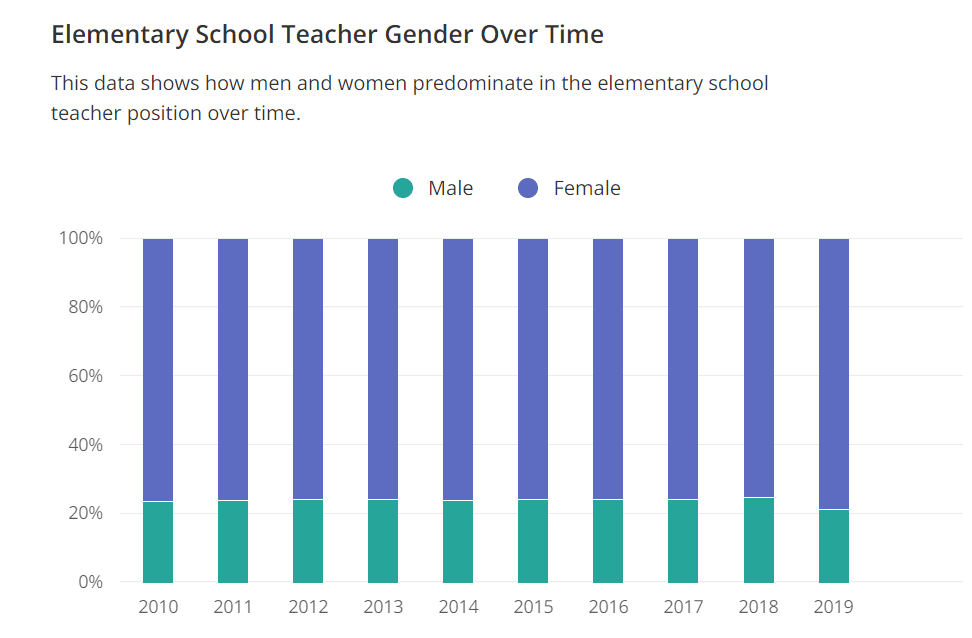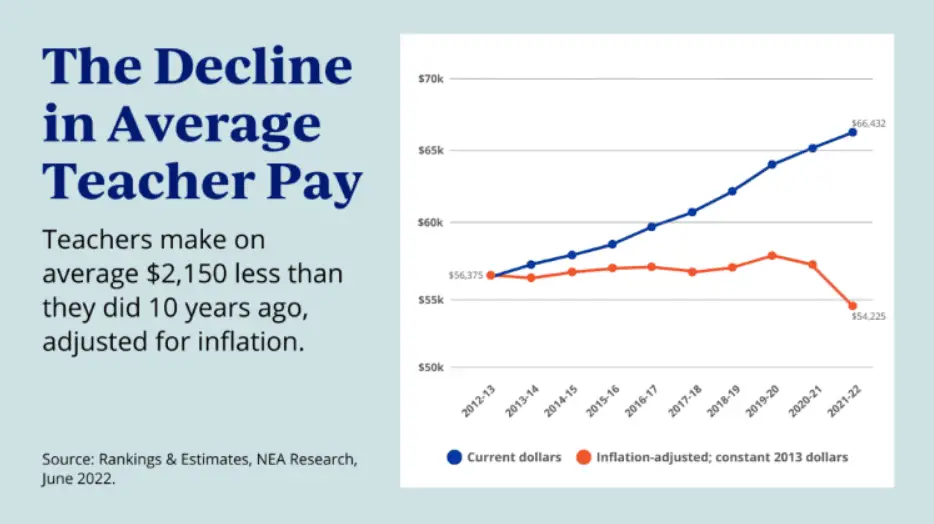Female teachers make up a larger proportion of elementary school teachers, meaning children are more likely to be taught by a female teacher than a male teacher at the elementary level. Is this trend set to continue, or is there a growing demand for more male teachers?
Male elementary school teachers are in demand because school districts aim to address the gender imbalance in the workplace, have a positive impact as role models for young people, and even dispel social stigma about men working in elementary schools. Additionally, male teachers exhibit a different behavior management style in the classroom.
This article will discuss why male elementary school teachers are in demand. I’ll also suggest ways of meeting the great need for male elementary school teachers. Let’s dive right in.
Why Male Elementary School Teachers Are in Demand
There is a high demand for male elementary school teachers worldwide for various reasons. Without understanding why we cannot put forward credible solutions. So, let’s talk more in-depth about these reasons.
To Address Gender Balance in the Workplace
According to a 2022 report about elementary school teachers’ jobs and demographics, more than 1,759,771 elementary school teachers are currently working in the USA. Of this number, 19.5% are men, while 80.5% are women.
Gender balance in the workplace is the difference and similarities among employees in terms of gender.
From these statistics, it’s clear that there is a significant gender imbalance in elementary education, with a considerable shortage of male teachers.

What’s worse is that the disparity appears to be growing rather than balancing out. The data shows that the percentage of male elementary school teachers was 24.96% in 2018 but declined to 21.72% the following year.
Men and women have different characteristics that make them unique. A comprehensive study involving over 23,000 participants from 26 cultures highlights how men and women differed in average personality. Women score higher on “agreeableness,” which constitutes polite, trustful, sympathetic, and accommodating traits. Conversely, men rated higher on “extraversion” and were seen to be more assertive, gregarious, and active.
How and why these differences exist is an interesting but complex debate. The distinction in the personality traits between men and women offers some explanation as to why there are more female elementary school teachers.
Irrespective of this, most people would agree that gender balance in the workplace has many benefits, including enhanced decision-making processes and improved performance. And for elementary schools in particular, evening out the gender ratio would equate to better social-emotional development and well-rounded education for the students.
As a result, male elementary school teachers are in demand to address gender balance in the workplace.
To Act As Male Role Models For Students
Male elementary school teachers are also in demand because children need male role models.
Having a male teacher in the classroom positively influences children’s knowledge about gender and gender dynamics. Students working with both male and female teachers learn from those they can relate to and those they perceive as the opposite sex. This will foster a sense of belonging and tolerance.
For under-achieving boys, the presence of a male elementary school teacher is life-changing. Data from around the world shows how low-income, single-parent families are almost always headed by the mother. Boys belonging to such households often lack a positive role model.

It might not be until high school or even until they reach the workplace where they encounter a male they can look up to, by which time it’s already too late.
Girls are constantly outperforming boys in class, and boys are more likely to be expelled or suspended from school. There is no doubt that these tendencies do not correlate with the lack of positive male role models in education.
School districts know that having more male elementary school teachers is advantageous; they positively influence the lives of both boys and girls by being reliable mentors.
To Dispel Stigma
“It takes some degree either of social ignorance or of personal courage for a man to enter teaching at the elementary school level,” stated George I. Brown, professor in education, in a 1960 Phi Delta Kappan article.
Although more than 60 years old, the quote is still evidently relevant today as we have already discovered, men only make up a fifth of elementary school teacher roles.
It would be naïve to think that the social stigma around a man working in an elementary school does not play a part. The generalization is that men lack compassion and a nurturing instinct, so, therefore, would not make effective elementary school teachers.
Ignorant views toward men currently working in elementary schools are not uncommon. A man working with young children is vulnerable to abuse about his masculinity or his sexual preferences. Furthermore, some people don’t trust men around children, and this suspicion is discouraging.
If elementary schools can get more male teachers on board, outdated views would gradually decline.
With the proper steps, more and more men would train as elementary school teachers and later work in elementary schools. The results would be a win-win situation for the students, teachers, and schools.
The YouTube video below shows how one man found his calling as an elementary teacher. Look out for the points discussed in this article as it also explores the stereotypical views facing male teachers.
To Bring a Different Behavior Management Style to the Classroom
I was cautious in my wording and explanation of this point. The assertion that men are inherently better at classroom management is a myth! Empirical evidence shows that females are just as effective at maintaining order and discipline in the classroom.
However, this study by Bjorn Hanson (2020) mentions how male students with emotional/behavioral disorders responded better to working with male teachers. Ultimately, students seem to connect better with staff that represents the demographics of the school, i.e., if the school has an equal ratio of boys to girls, then the school’s faculty should mirror this.
In addition, as mentioned earlier regarding the difference in personality traits between men and women, male teachers bring a different behavior management style to the class.
The “extraversion” characteristics most common in men – assertiveness, decisiveness, and thriving in a group setting – are better suited for some students.

Risk-taking is another trait more associated with men. This becomes useful when a teacher has the confidence to take calculated risks in making their lessons more adventurous. Consequently, behavior becomes less of an issue if classes are exciting and engaging.
To emphasize, male teachers are not better at classroom management than female teachers. They do, however, offer a unique style and approach that motivates students differently. This is another reason why there is a high demand for male elementary school teachers.
How To Meet the Demand for Elementary School Teachers
The shortage of male elementary school teachers worldwide is worrying. If stakeholders don’t take decisive action, the gender imbalance will continue to grow, further affecting future generations.
Below is how to meet the demand for male elementary school teachers.
Increase Salaries
The number of male teachers leaving the profession is increasing rapidly. The main factor behind this is the erosion of pay over time. It is shocking to read that teachers’ salaries are actually lower now than ten years ago. When adjusted against inflation, teachers are earning 4% less since 2012.

Many people would agree that teachers are paid a wage that does not match the demands of the profession.
But salary issues seem to have a more significant impact on men compared to women. Research states that men tend to be more responsive to changes in the relative wage levels, meaning the decline in pay explains the fall in the proportion of male teachers currently working.
More teachers are realizing that the sacrifice and dedication they show are not worth the compensation. Leaving the profession becomes more and more tempting, but the research tells us that men are more likely to actually go ahead with it.
If we take the conventional view that most men are primary breadwinners, then how can they support their families on a waning teacher’s salary?
The solution is simple – to increase wages! If education stakeholders are serious about boosting the recruitment and retention of male teachers, then it has to start with higher salaries.
Encourage Young Men To Pursue Teaching Degrees
The number of male educators in elementary schools will continue to decline if young men don’t pursue teaching degrees.
Since you must obtain a degree to become an elementary school teacher, universities should make a concerted effort to recruit more young men into teaching programs. For instance, universities could develop scholarships for males interested in pursuing teaching degrees.
As a result, more young men would enroll for teaching degrees and later become elementary school teachers to meet the high demand.
We must also change our attitudes and work tirelessly to dispel any stigma attached to men working in elementary schools. Young men would find a career in teaching more appealing if teaching had a better rep. The lack of respect and trust toward teachers is a major deterrent.
Luckily, there is hope. See in the video how other countries offer more favorable conditions than the US, hence why they attract more teachers.
Conclusion
Men make up less than 20% of elementary school teachers, and the gender imbalance is only widening. This creates a problem for the future generation of boys and girls because they miss out on positive male role models at such a critical stage of their lives.
If the world wants to meet the high demand for male elementary school teachers, all stakeholders must intervene to ensure that they address the factors that discourage men from joining the profession.
Sources
- Zippia: Elementary School Teacher Demographics and Statistics in the US
- EdSource: Male teachers provide important role models
- CNBC: 2020 has shone a light on the importance of good teachers, but many are paid less than a living wage in the U.S.
- Pubmed: Gender differences in personality traits across cultures: robust and surprising findings
- Marian University: Male Teachers Play an Important Role in the Future of Education
- Walden University: Education Gender Gap: Are Boys and Girls on Equal Ground
- National Education Association: Average Teacher Salary Lower Today Than Ten Years Ago
- YouTube: Vox: Teaching in the US vs. the rest of the world
- YouTube: PBS NewsHour: How this man found his calling as an early elementary teacher
- Bethel University: Do We Need More Male Teachers for an Increasing Population of Male Students With Emotional and Behavioral Disorders?

